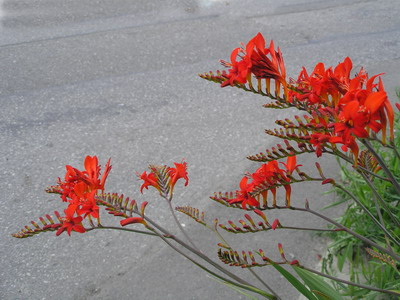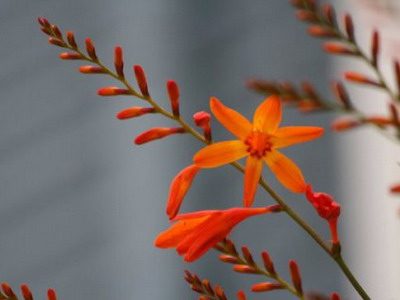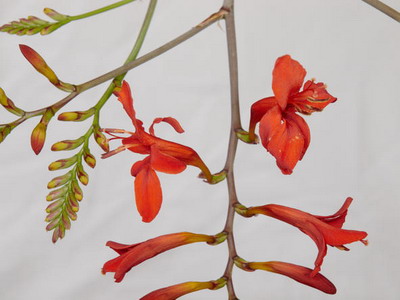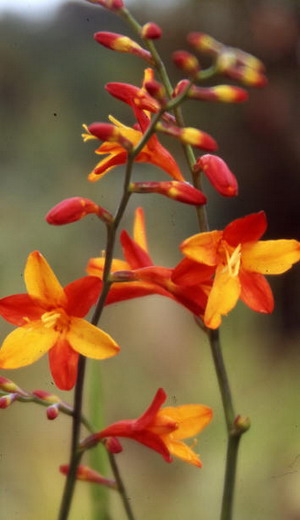 Crocosmia (Crocosmia) is a genus of herbaceous bulbous perennials from the iris family (Iridaceae), the natural habitat of which is the forest and mountainous regions of southern Africa. Grown in gardens as an ornamental crop .
Crocosmia (Crocosmia) is a genus of herbaceous bulbous perennials from the iris family (Iridaceae), the natural habitat of which is the forest and mountainous regions of southern Africa. Grown in gardens as an ornamental crop .
- Family: iris.
- Origin: South Africa.
- Rhizome: corm.
- Stem: thin, branching.
- Leaves: narrow, xiphoid.
- Fruit: box.
- Reproductive ability: propagated by corms, less often by seeds.
- Illumination: light-requiring.
- Watering: moderate.
- Content temperature: insufficiently winter-hardy.
- Flowering time: July-September
General information about the crocosmia flower
Crocosmia (see photo below) is an elegant flowering plant 40 – 100 cm high, similar in appearance to a miniature gladiolus. It has medium-sized, up to 3 cm in diameter, corms covered with a reticulum, from which a fan of basal leaves grows in spring, hard, narrow, 40 to 60 cm long, 0.7 to 2.5 cm wide.

Crocosmia flower in the photo
Due to their African origin, most species only overwinter in mild snowy conditions, requiring good drainage and careful cover. In the middle lane, the corms are dug up at the end of the season, replanted in the spring, and in mid-July, 3-4 peduncles grow from each, thin, branching, up to 1 m high. At the end of the stem, a drooping paniculate inflorescence of three to five flowers is formed in natural species , eight to ten – in modern garden varieties.
The crocosmia flower is usually yellow, orange or red in color, its diameter is 2-4 cm, and the six-parted perianth has a cylindrical or funnel-shaped tube and oval, lanceolate-oblong or ovoid prostrate lobes. In the middle lane, flowering begins in mid-July, in warmer regions where corms are not dug up for the winter, already in June and continues until September. Individual flowers do not bloom simultaneously on the stem, first at the base, and then to the top, which allows the culture to look decorative until the end of the season.
A plant in a temperate climate bears fruit well, forming a round multi-seeded box with large, reddish-brown seeds by the end of autumn, which are successfully used for propagation.
Why are flowers called crocosmia?
The Latin name, crocosmia, consisting of two Greek words: “crocos” (crocus or saffron) and “osme” (smell), the flower received for the faint aroma of dried petals, reminiscent of the smell of saffron: The outdated name of crocosmia, montbretia (montbretia) is also often used , given to the culture in honor of the French botanist Cockbert de Montbreu.
Japanese gladiolus is another popular name for the plant, obviously associated with its similarity with gladiolus, not only in appearance, but also in a number of biological features (bulb structure, agricultural cultivation techniques).
Crocosmia has been present in the gardens of Europe since the 19th century, but was previously considered a rather exotic and rare culture. Nowadays, thanks to selection work, it is widely grown all over the world, decorates flower beds, and is used for cutting.
Types and varieties of crocosmia for the garden
There are about 50 species in the genus, growing in Southwest Africa, as well as in Tanzania, Zimbabwe, Mozambique. The only species found outside the African continent is C. ambongensis endemic to Madagascar. Most crocosmia are found only in the wild, many of them are little studied.
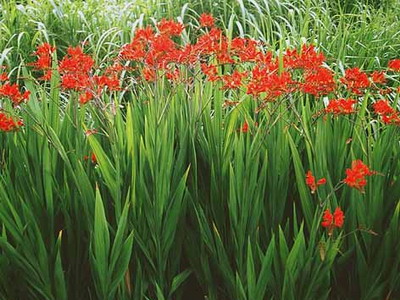
In culture, mainly four are used:
K. golden (C. Aurea) – one of the most large-flowered, grows in forests of tropical and temperate regions, was first described in 1832. It got its name for bright yellow-orange flowers, the length of which reaches 5 cm. It grows up to 70-100 cm, has smooth linear or xiphoid basal leaves. In culture since 1846, grown for cutting. Tolerates some shade as it is a woodland plant. Blooms in autumn. It is thermophilic, grows well in protected ground, does not hibernate in the middle lane.
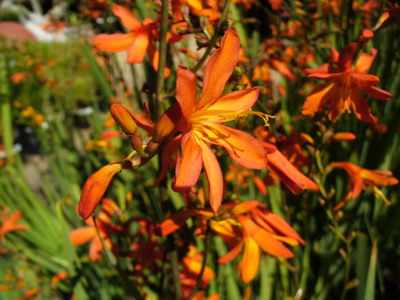
K. Potts (C. Pottsii) – moisture-loving, photophilous, with small flowers and smooth narrow leaves, found along river banks, in wetlands of southern Africa. Successfully adapts to various adverse conditions. Natural forms are rare in gardens, but the hybrids created on their basis are very viable, grow quickly, and often weed.
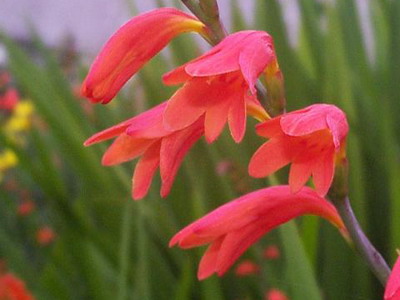
K. massonorum (C. Masoniorum) is common in the highlands of South Africa, therefore it is more frost-resistant than previous species. It has corrugated xiphoid leaves, large bulbs and small flowers that bloom in mid-summer. It grows up to 60-80 cm, blooms for a long time and abundantly.

C. paniculata (C. Paniculata) is another mountain variety that has much in common with the previous one. It is also frost-resistant, has corrugated leaves, bright orange medium-sized flowers appear in June.
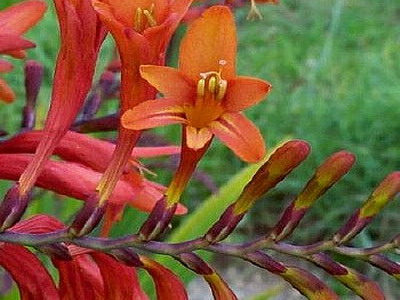
Natural forms of crocosmia are grown quite rarely, mainly numerous varieties and hybrids are cultivated, created on the basis of the varieties described above. There are about 400 cultivars with yellow, orange, red flowers, occasionally pink and white crocosmia are found.
Crocosmia Montebrecia vulgaris

Crocosmia Montebrecia vulgaris in the photo
The first hybrid was created in 1880 when Victor Lemoine, a breeder from France, crossed Potts crocosmia and golden. The resulting plant was named by him Montbrecia vulgaris, and is now isolated as a separate species known as common crocosmia (C. x crocosmiiflora (Lemoine) N.E. Br.). It has a thin branched stem up to 1 m tall and medium-sized, up to 5 cm in diameter, funnel-shaped flowers, the color of which varies from yellow to orange-red. It blooms in July-August, in the inflorescence there can be up to 10 flowers at the same time.
Crocosmia Lucifer and other hybrids
In decorative floriculture, numerous cultivars are most often grown, created on the basis of this particular hybrid. All of them are very decorative, large-flowered, but not frost-resistant, the bulbs do not hibernate in the ground.
Most interesting:
Emily McKenzie , a late cultivar growing to 60 cm, with variegated flowers that are brownish with bright orange spots at the base. Develops best in light partial shade.
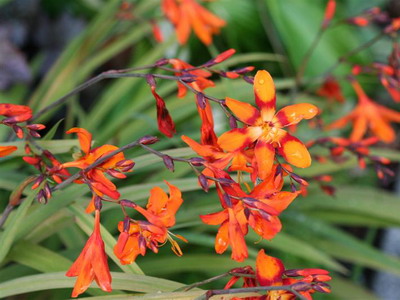
Star of the East (Star of the East) , the largest of the cultivars, blooming from August to October. The flowers are star-shaped, painted in an apricot-orange tone with a lighter core, their diameter reaches 10-12 cm. The least frost-resistant of all varieties.

In Russia they also grow:
Orange Lady Wilson.
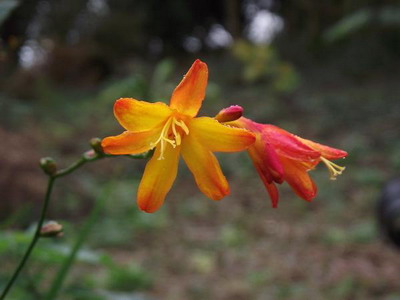
Orange Delight.
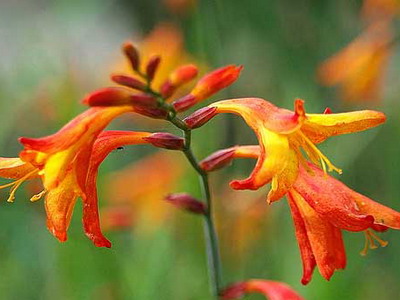
Red Vesuvius.
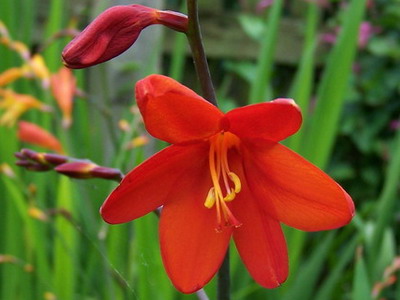
Yellow Reingold and others.

Of the hybrids of other species are popular:
Crocosmia Lucifer (Lucifer) is a hybrid of C. Paniculata, which inherited from it high frost resistance and unpretentiousness. This is perhaps the most brightly colored variety, with tomato-red erect flowers, reaching a height of 90-110 cm.

Culzean Pink , a cultivar derived from C. Pottsii, has a delicate pale pink color unusual for a culture.
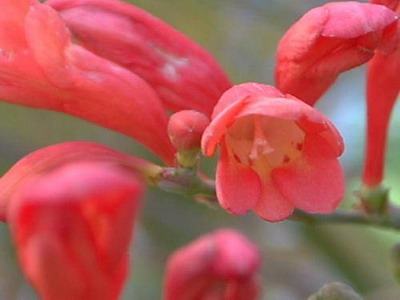
In the photos below – flowers of various crocosmia, including the varieties and species described above:
